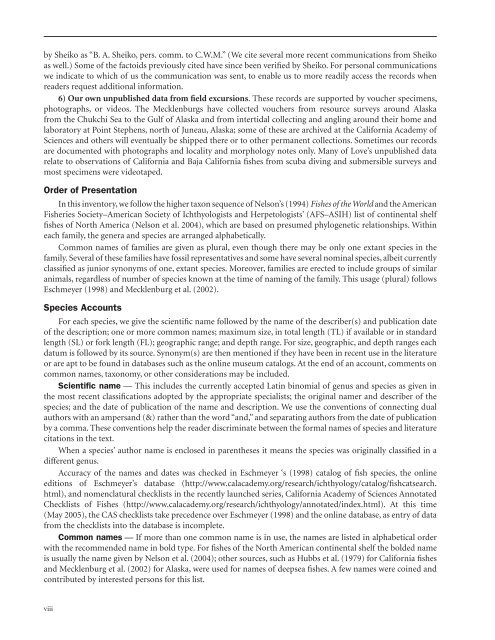Untitled - Alaska Resources Library
Untitled - Alaska Resources Library
Untitled - Alaska Resources Library
You also want an ePaper? Increase the reach of your titles
YUMPU automatically turns print PDFs into web optimized ePapers that Google loves.
y Sheiko as “B. A. Sheiko, pers. comm. to C.W.M.” (We cite several more recent communications from Sheiko<br />
as well.) Some of the factoids previously cited have since been verified by Sheiko. For personal communications<br />
we indicate to which of us the communication was sent, to enable us to more readily access the records when<br />
readers request additional information.<br />
6) Our own unpublished data from field excursions. These records are supported by voucher specimens,<br />
photographs, or videos. The Mecklenburgs have collected vouchers from resource surveys around <strong>Alaska</strong><br />
from the Chukchi Sea to the Gulf of <strong>Alaska</strong> and from intertidal collecting and angling around their home and<br />
laboratory at Point Stephens, north of Juneau, <strong>Alaska</strong>; some of these are archived at the California Academy of<br />
Sciences and others will eventually be shipped there or to other permanent collections. Sometimes our records<br />
are documented with photographs and locality and morphology notes only. Many of Love’s unpublished data<br />
relate to observations of California and Baja California fishes from scuba diving and submersible surveys and<br />
most specimens were videotaped.<br />
Order of Presentation<br />
In this inventory, we follow the higher taxon sequence of Nelson’s (1994) Fishes of the World and the American<br />
Fisheries Society–American Society of Ichthyologists and Herpetologists’ (AFS–ASIH) list of continental shelf<br />
fishes of North America (Nelson et al. 2004), which are based on presumed phylogenetic relationships. Within<br />
each family, the genera and species are arranged alphabetically.<br />
Common names of families are given as plural, even though there may be only one extant species in the<br />
family. Several of these families have fossil representatives and some have several nominal species, albeit currently<br />
classified as junior synonyms of one, extant species. Moreover, families are erected to include groups of similar<br />
animals, regardless of number of species known at the time of naming of the family. This usage (plural) follows<br />
Eschmeyer (1998) and Mecklenburg et al. (2002).<br />
Species Accounts<br />
For each species, we give the scientific name followed by the name of the describer(s) and publication date<br />
of the description; one or more common names; maximum size, in total length (TL) if available or in standard<br />
length (SL) or fork length (FL); geographic range; and depth range. For size, geographic, and depth ranges each<br />
datum is followed by its source. Synonym(s) are then mentioned if they have been in recent use in the literature<br />
or are apt to be found in databases such as the online museum catalogs. At the end of an account, comments on<br />
common names, taxonomy, or other considerations may be included.<br />
Scientific name — This includes the currently accepted Latin binomial of genus and species as given in<br />
the most recent classifications adopted by the appropriate specialists; the original namer and describer of the<br />
species; and the date of publication of the name and description. We use the conventions of connecting dual<br />
authors with an ampersand (&) rather than the word “and,” and separating authors from the date of publication<br />
by a comma. These conventions help the reader discriminate between the formal names of species and literature<br />
citations in the text.<br />
When a species’ author name is enclosed in parentheses it means the species was originally classified in a<br />
different genus.<br />
Accuracy of the names and dates was checked in Eschmeyer ‘s (1998) catalog of fish species, the online<br />
editions of Eschmeyer’s database (http://www.calacademy.org/research/ichthyology/catalog/fishcatsearch.<br />
html), and nomenclatural checklists in the recently launched series, California Academy of Sciences Annotated<br />
Checklists of Fishes (http://www.calacademy.org/research/ichthyology/annotated/index.html). At this time<br />
(May 2005), the CAS checklists take precedence over Eschmeyer (1998) and the online database, as entry of data<br />
from the checklists into the database is incomplete.<br />
Common names — If more than one common name is in use, the names are listed in alphabetical order<br />
with the recommended name in bold type. For fishes of the North American continental shelf the bolded name<br />
is usually the name given by Nelson et al. (2004); other sources, such as Hubbs et al. (1979) for California fishes<br />
and Mecklenburg et al. (2002) for <strong>Alaska</strong>, were used for names of deepsea fishes. A few names were coined and<br />
contributed by interested persons for this list.<br />
viii
















